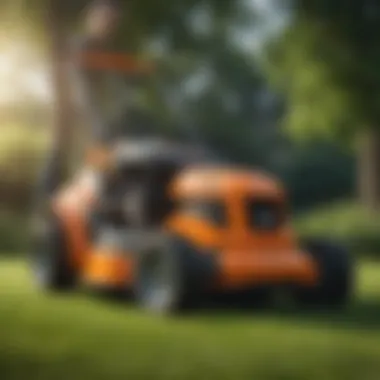Electric Lawn Cutters: A Comprehensive Analysis


Intro
Electric lawn cutters have gradually emerged as an essential tool for both professional landscapers and the average homeowner. They represent a significant shift in how we approach lawn maintenance, particularly in light of growing environmental concerns. This article examines various facets of electric lawn cutters, their technological advancements, and the practicality they offer in contemporary landscaping. With a comprehensive understanding of these tools, users can make informed choices that enhance their landscaping efforts while promoting sustainability.
Topic Overview
Definition and Importance
Electric lawn cutters, often referred to as electric mowers, are powered by electricity instead of traditional gas engines. This shift not only aims to reduce carbon emissions but also enhances user convenience. Electric mowers are quieter, typically lighter, and require less maintenance than their gas counterparts. As society increasingly emphasizes eco-friendly solutions, understanding the role of electric lawn cutters becomes crucial for green-centric gardening practices.
Brief History and Evolution
The history of electric lawn cutters dates back to the early 20th century, when the first electric mowers were introduced. However, it wasn't until the late 20th century that significant advancements in battery technology and electric motors transformed them into viable alternatives to gas mowers. Today, manufacturers like EGO Power+ and Greenworks have led the market, continuously innovating to improve performance and efficiency.
Key Techniques and Innovations
Sustainable Farming Practices
The integration of electric lawn cutters embodies sustainable farming practices. Users can mow their lawns without contributing to air pollution or noise pollution that is common with gas-powered mowers. This shift supports overall healthier ecosystems in residential neighborhoods and public spaces.
Advanced Agronomic Technologies
Recent innovations have made electric lawn cutters more effective than ever. Some advanced features include:
- Smart Sensors: These adjust cutting height based on grass length.
- Battery Management Systems: Optimizing charging and extending battery life.
- Self-Propelling Mechanisms: Reducing physical strain on the user.
These technologies not only enhance user experience but also align with the goals of sustainable landscaping practices.
Practical Applications
Step-by-Step Guides
Using an electric lawn cutter can be straightforward with the right approach. Here are essential steps to follow for effective lawn maintenance:
- Charge the Battery: Ensure that your mower's battery is fully charged before use.
- Check Blades: Inspect blades for any damage or dullness as sharp blades ensure a clean cut.
- Adjust Cutting Height: Set the desired cutting height based on your lawn type.
- Mow Effectively: Start mowing in a pattern that prevents grass clippings from being pushed into garden beds.
- Clean the Mower: After mowing, clean the undercarriage to prevent grass build-up.
Case Studies or Real-World Examples
Numerous homeowners share positive experiences with electric lawn cutters. For instance, one homeowner replaced a gas mower with an Honda HRX217VLA electric model. They reported quieter operation and zero need for gas or oil, alongside reduced maintenance costs. Additionally, for community spaces, electric mowers are leveraged during events to emphasize eco-friendly practices.
"Electric lawn cutters demonstrate that innovation can coexist with ecological responsibility, fundamentally altering our approach to yard care."
Prologue to Electric Lawn Cutters
Electric lawn cutters are becoming more popular as people look for efficient and environmentally friendly ways to maintain their lawns. These tools offer a modern alternative to traditional gas-powered mowers, appealing to a wide range of users. Understanding the role of electric lawn cutters is essential for anyone interested in landscaping or lawn care. This section aims to lay the groundwork by discussing the significance, benefits, and considerations of using electric lawn cutters in the context of sustainable lawn management.
Understanding the Basics
To appreciate electric lawn cutters, one must first understand their functionality. These devices operate using electric power, which can come from batteries or directly from a plugged-in source. The core components include an electric motor, which drives the blades for cutting grass effectively. Generally, they are lighter than gas mowers, making them easier to maneuver and operate.
Electric lawn cutters often produce less noise when cutting grass. This feature makes them suitable for urban settings where noise regulations may be in place. Notably, electric models do not emit harmful gases, contributing to cleaner air, which is crucial in today's environment.
In addition, these tools tend to have lower operating costs compared to their gas counterparts. The absence of fuel requirements and fewer moving parts leads to less frequent maintenance. For many homeowners and professionals alike, this translates to saved time and money.
Evolution of Lawn Care Equipment
The history of lawn care equipment spans over several decades, witnessing substantial transformation. Initially, lawn care relied heavily on manual tools like scythes and reel mowers. These devices required significant physical effort and time to achieve desired results. With advancements in technology, the entry of gasoline-powered mowers marked a pivotal shift in lawn care, offering increased convenience and efficiency.
However, the emergence of electric lawn cutters has initiated a new phase in this evolution. As environmental concerns grew, electric models began to gain traction. Innovations in battery technology enhance performance, enabling longer run times and efficient cutting. Moreover, modern electric mowers come equipped with advanced features such as adjustable cutting heights, which allow for tailored grass management.
Overall, the evolution of lawn care equipment reflects a balance between efficiency and environmental awareness. With electric lawn cutters, both professional landscapers and casual gardeners can achieve their goals without compromising ecological safety.
The Technology Behind Electric Lawn Cutters
The technology behind electric lawn cutters plays a vital role in their performance, efficiency, and overall appeal. Knowing how various components function allows users to make informed choices and maximize the usage of the equipment. As the industry progresses, electric lawn cutters are gaining traction, partly due to their significant advantages in terms of environmental impact and cost-effectiveness.


Motor Types and Power Sources
The core of any electric lawn cutter lies in its motor. The type of motor determines the power and efficiency of the machine, impacting its cutting ability and performance.
Electric lawn cutters typically use either brushed or brushless motors. Brushed motors are traditional and often less expensive, but they come with certain drawbacks such as increased wear and tear over time, which can affect their longevity. On the other hand, brushless motors are becoming increasingly popular. They are more efficient, quieter, and require less maintenance. The reduced friction in brushless motors leads to better battery management and overall performance, which is a commendable feature compared to brushed counterparts.
Power sources are another critical aspect. Most electric lawn cutters run on two types of power sources: battery-operated or corded. Battery-operated models provide convenience and flexibility. They are great for small to medium-sized lawns, making them easy to maneuver without being tethered to an outlet. This freedom of movement enhances the user experience, especially for those with larger properties or more complex landscaping. However, they need periodic recharging, which can interrupt the cutting process.
Corded models, in contrast, rely on a direct electric supply. This can restrict movement somewhat due to the cord length but ensures an continuous power flow. These are generally lighter and easier to use for extensive cuts, making them suitable for residential and commercial use. However, users must be mindful of potential tripping hazards associated with cords.
Battery vs Corded Options
In the realm of electric lawn cutters, the choice between battery and corded options is often a matter of personal preference and specific yard requirements.
Analysing Battery Life
Battery life is a pivotal factor in the effectiveness of battery-operated electric lawn cutters. Users depend on the ability of the mower to finish the job without the need for frequent recharges. The battery's capacity, measured in amp-hours, greatly influences the total operational time. Commonly, lithium-ion batteries are preferred due to their lightweight and longer lifespan compared to other battery types, such as lead-acid.
One significant advantage of lithium-ion batteries is their rapid charging capability. Therefore, if users feel their battery is running low, they can quickly recharge it during breaks, making this option highly efficient for mowing.
Key features of battery life include:
- Capacity: Indicates how long the cutter can run per charge.
- Runtime: Helps understand if the unit can handle the user's lawn size.
However, these benefits come with some disadvantages. For instance, once the battery reaches the end of its life cycle, it can require costly replacements, which is a consideration for budget-conscious consumers.
Exploring Cord Length
Cord length is another critical element to examine when deciding on an electric lawn cutter. A longer cord generally increases the mowing range, allowing users to cover larger areas without the need to unplug and re-plug. It is advisable to consider a cord length that will suit your lawn's size and layout.
Key aspects linked to cord length:
- Reach: A longer cord facilitates ease of movement across various lawn designs.
- Safety: A specific cord length can help avoid tripping hazards, especially in localized areas.
While longer cords provide reach, they also introduce challenges. For instance, the risk of entanglement might increase, making it essential to choose the right approach. Users must also utilize heavy-duty extension cords for prolonged usage to ensure safety and performance.
Benefits of Using Electric Lawn Cutters
Electric lawn cutters have gained significant popularity due to several factors that make them an attractive choice for many users. From environmental benefits to cost-effectiveness, these machines cater to both casual gardeners and dedicated lawn care enthusiasts. Understanding the various advantages helps individuals make informed choices in yard maintenance.
Environmental Considerations
Reduced Carbon Emissions
One of the most significant advantages of using electric lawn cutters is the reduction in carbon emissions. Unlike gas-powered alternatives, electric cutters do not emit greenhouse gases while in operation. This feature is crucial in the context of increasing concerns about climate change. The key characteristic of reduced carbon emissions is that they align with environmentally friendly practices, making them a popular choice among eco-conscious consumers.
The unique aspect of this benefit is that by using electric lawn cutters, individuals contribute to cleaner air quality and lower overall pollution levels. Although the manufacturing processes may still involve some emissions, the operational phase remains much cleaner. This makes electric cutters a more beneficial option for those seeking sustainable land management practices in gardening.
Noise Pollution Concerns
Another important benefit is the significant reduction in noise pollution associated with electric lawn cutters. Traditional gas-powered mowers often produce loud noise that can disturb neighbors and wildlife. In contrast, electric models operate at a much quieter level.
The key characteristic of noise pollution concerns is the comfort and tranquility they bring to the users and their surroundings. This aspect makes electric machines a favorable choice for residential areas where maintaining peace is vital. The unique feature of quiet operation ensures that users can mow their lawns early in the morning or later in the evening without disturbing others. The advantages of noise reduction are clear, as it enhances community harmony while making lawn maintenance less intrusive.
Cost Efficiency and Maintenance
Comparative Costs: Electric vs Gas
When evaluating lawn care equipment, cost plays a significant role in decision-making. Typically, electric lawn cutters are more affordable to purchase than their gas-powered counterparts. They usually have lower operational costs since the electricity required to run them is less expensive than gas. The key characteristic of comparative costs is that they provide excellent value for consumers over time, especially for those who mow their lawns frequently.
Another unique feature is the long-term savings on fuel and oil expenses. While the initial investment in a quality electric mower may be comparable to a gas model, savings accumulate through reduced energy bills, leading to financial benefits in the long run. The advantage of choosing electric over gas translates into sustainable financial management in lawn care.
Maintenance Requirements
Maintenance of electric lawn cutters tends to be less complicated and more convenient than that of gas-powered machines. Electric models require fewer mechanical adjustments and need less frequent servicing, which saves time and money. The key characteristic of maintenance requirements is the simplicity of upkeep. Users can typically handle minor maintenance tasks themselves, reducing dependence on professionals.


The unique aspect of this feature is the absence of the required oil changes, air filter maintenance, or spark plug replacements found in gas-powered models. This leads to an overall lower commitment of time and resources for maintaining lawn care equipment. The advantages of less intensive maintenance are appealing to busy individuals who want to focus more on landscaping rather than upkeep.
Practical Use of Electric Lawn Cutters
The practical use of electric lawn cutters is increasingly relevant in today's landscaping discussions. This section aims to discuss the essential aspects and considerations that come into play when utilizing electric lawn cutters effectively. Understanding their operation, advantages, and everyday application can enhance the lawn maintenance experience while promoting sustainable practices.
Choosing the Right Model
Selecting the correct electric lawn cutter model is crucial for efficiency and satisfaction. Different models come with various features tailored to specific needs.
Key Features to Look For
When choosing an electric lawn cutter, consider key features such as cutting width, weight, and adjustable height settings. These aspects contribute significantly to the overall performance and user experience. A wider cutting width means efficiency in mowing larger areas, while a lightweight design makes the device more maneuverable. Adjustable height settings allow for versatility, catering to various grass types and growth patterns.
One unique characteristic to look for is a mulch feature. This feature can return nutrients to the soil, promoting healthier grass growth. However, some cutters might be better for creating fine clippings, especially for those prioritizing aesthetics in their lawn care.
Brand Recommendations
Brand reputation plays a major role in ensuring quality and reliability. Some brands stand out due to their commitment to innovation and customer satisfaction. For instance, brands like Greenworks and Black+Decker have a history of producing dependable electric lawn cutters.
A notable feature of these brands is their warranty and customer service support, which can be beneficial in case of technical issues. That reassurance can significantly enhance the purchasing decision, knowing that help is readily available if needed.
Operational Tips
Proper operation of electric lawn cutters can maximize their effectiveness. Understanding how to use these tools efficiently ensures a neat and well-maintained lawn.
Optimal Cutting Heights
Setting the optimal cutting height is essential for achieving the best results. Generally, this height varies depending on the grass type, but most experts suggest cutting about one-third of the grass blade. A properly chosen height prevents stressing the grass and encourages robust growth.
Having the option to adjust the height settings is advantageous, as it allows for seasonal adjustments based on grass health and growth stages. Failure to set the correct height can lead to damaged grass, which might result in a less attractive lawn.
Best Practices for Maintenance
Regular maintenance is key to prolonging the life and performance of electric lawn cutters. Key practices include cleaning the blades and ensuring the motor is free from debris. These actions help maintain optimal cutting efficiency.
Additionally, storing the cutter correctly after use is vital. Keeping it out of damp environments mitigates the risk of rust and electrical issues. Taking these steps can enhance the cutter's longevity and overall effectiveness, ensuring it remains a reliable tool for years to come.
Comparative Analysis: Electric vs Gas-Powered Lawn Cutters
The decision between electric and gas-powered lawn cutters is not merely based on personal preference. Understanding the distinctions between these types can significantly affect performance, cost, and environmental impact. This section will dissect the comparative aspects of these two categories, focusing on performance metrics and user experience. Each aspect provides valuable insights for prospective buyers or enthusiasts in lawn care, enabling them to make informed choices.
Performance Metrics
Performance metrics are vital when assessing any lawn cutter, whether electric or gas. These metrics highlight efficacy and suitability for various lawn types and conditions.
Cutting Power and Speed
Cutting power plays a crucial role in determining how efficiently a lawn cutter performs its task. Electric models, for instance, are designed with high torque motors that can handle dense grass with ease. This characteristic allows for consistent cut quality without much strain. Gas-powered cutters, on the other hand, often have more horsepower, making them suitable for large or rugged terrains.
However, cutting speed can fluctuate based on the models. Electric cutters generally operate with a consistent performance, regardless of the grass type, which minimizes user fatigue. In situations where rapid cutting is essential, such as mowing an expansive lawn quickly, gas-powered models may be favored due to their higher RPM capabilities.
Both power types come with unique advantages. While electric cutters tend to be quieter and less complex, gas models offer mobility without the restrictions of cords or battery limitations. This can be particularly beneficial in larger landscapes.
"The choice between electric or gas-powered lawn cutters boils down to the specific conditions of your lawn and your personal preferences in maintenance and usage."
Durability and Longevity
Durability is another vital aspect of prolonging the life of a lawn mower. Electric lawn cutters generally have fewer mechanical parts. This results in lower chances of malfunction, but their longevity is often tied to battery life or cord conditions. Maintaining the battery's health is essential to ensure reliability over time.
Gas-powered mowers, with proper maintenance, can last longer due to their robust construction. However, they often require regular servicing, including oil changes and air filter replacements. Users must also consider that gas models may suffer from fuel system issues if not used frequently, which can detract from their lifespan.
In essence, both electric and gas lawn cutters present distinct durability characteristics. Electric models excel in low maintenance due to fewer mechanical systems, while gas models may offer a longer life under diligent care and usage practices.


User Experience
User experience encapsulates what it feels like to operate each type of mower and the physical demands associated with the task.
Ease of Use
When it comes to ease of use, electric lawn cutters are highly regarded. They tend to be lighter and more maneuverable. For users with small to medium lawns, this translates into less physical strain while mowing. The absence of gas and oil adds to the simplicity of operation. Starting mechanisms in electric models are often as simple as pressing a switch, eliminating the struggles associated with pull cords in gas mowers.
That said, gas-powered mowers can deliver superior power. This advantage can be crucial for larger or more challenging terrains where robust performance is needed. Yet, the trade-off often involves the added complexity of operation and maintenance.
Physical Labour Considerations
Physical labour required in mowing varies significantly between electric and gas-powered models. Users of electric mowers often experience less strain and fatigue, allowing for longer mowing sessions without discomfort. Besides, the environment surrounding electric machines is generally quieter, providing a less stressful working atmosphere.
Gas-powered cutters may impose a heftier physical toll. Their weight and required maintenance can lead to increased user fatigue, especially in larger tasks. They demand more engagement in terms of maneuvering and dealing with fuel, which can be a drawback for some users.
Emerging Trends in Electric Lawn Cutting Technology
The realm of lawn care is undergoing transformation, particularly with the rise of electric lawn cutters. Emerging trends are shaping how homeowners and professionals approach lawn maintenance. These innovations not only maximize efficiency but also align with evolving environmental standards. Understanding these trends is crucial for making informed choices about landscaping technology. This section will explore key advancements, including robotic cutters and smart features.
Robotic Lawn Cutters
Autonomous Navigation
Autonomous navigation is a standout feature of robotic lawn cutters. It allows these machines to operate independently, mapping out the lawn and adjusting their route as necessary. This capability minimizes human intervention, making lawn care more convenient.
One key characteristic of autonomous navigation is its ability to optimize cutting patterns. By analyzing the lawn contours, these cutters ensure uniform grass height, enhancing the overall aesthetic of the yard. While it seems advantageous, the technology might face challenges, like barriers or complex garden layouts, which could affect performance. Still, the benefits of reduced manual effort and time savings are significant.
Scheduling and App Integration
The capability for scheduling and app integration is becoming increasingly popular in electric lawn care. These features allow users to set specific mowing times, ensuring the lawn is maintained even when householders are busy. By using a simple smartphone application, users can program mowing schedules, monitor battery life, and even control the cutter remotely.
A key benefit of this integration is enhanced convenience. Users can operate their lawn cutters from anywhere, reducing the need for physical presence. However, reliance on technology may present risks, such as connectivity issues or battery drain at inopportune times. Overall, these functions represent a modern approach to efficient lawn care.
Smart Features
Integration with IoT
The integration of Internet of Things (IoT) technology into electric lawn cutters is significant. This connection allows for real-time data exchange and monitoring. IoT integration means that users can receive updates on their mower's performance, maintenance needs, and even climate predictions affecting their lawn.
The most appealing aspect of IoT integration is its potential for preventive maintenance. By analyzing data trends, users can proactively schedule services, extending the machine's lifespan. However, the technology requires a stable internet connection and can be complex for less tech-savvy users.
User-Focused Innovations
User-focused innovations are driving improvements in the design and functionality of electric lawn cutters. This includes ergonomic designs that are lighter and easier to maneuver. Features like adjustable handles and compact forms cater to varying user needs, making lawn care less daunting for all.
These innovations have proven beneficial for individuals with physical limitations. The focus on user experience enhances accessibility, encouraging more people to engage in lawn maintenance. Challenges such as higher costs for advanced technical features remain. Nevertheless, the overall movement toward user-centric designs reflects a promising trend in the future of lawn care.
Culmination: The Future of Lawn Care
In the ever-evolving field of lawn care, electric lawn cutters remain at the forefront. This article emphasizes their significance as we carefully uncover their advantages and challenges. With increasing concerns over pollution and climate change, the transition to electric alternatives not only aligns with environmental goals but also introduces innovative solutions for lawn management. As consumers become more aware of their environmental footprint, the demand for sustainable gardening practices will continue to grow.
Assessing Long-Term Value
When evaluating electric lawn cutters, one must consider their long-term value. Not just initial costs, but maintenance, lifespan, and efficiency are crucial factors.
- Electric models tend to have lower operational costs compared to gas-powered machines.
- The durability of high-quality electric cutters ensures they could operate for many years without significant repairs.
- Some models offer extended warranties, which cushion initial investments and provide peace of mind.
Comparatively, maintenance for electric options is simpler. Charging a battery or plugging in can often be less cumbersome than dealing with the complexities of gasoline engines. Moreover, avoiding oil changes and emissions checks saves time and helps the user stay focused on the larger picture of sustainability.
Sustainable Practices in Lawn Care
Sustainable lawn care practices are not solely about the tools used. It's also about how we manage our green spaces. Electric lawn cutters support a philosophy rooted in ecological balance. Some elements to consider include:
- Use of Electric Models: By lessening reliance on fossil fuels, these cutters minimize the overall carbon footprint associated with lawn maintenance.
- Proper Scheduling: Conducting lawn care during optimal times can further reduce environmental impact. This reduces the likelihood of disturbing wildlife during nesting seasons or peak heat times.
- Grasscycling: Returning cut grass to the lawn helps nurture the soil, providing nutrients naturally while increasing moisture retention.
Implementing these practices can build a sustainable tradition in lawn care, encouraging others within the community to follow suit.
"The future of lawn care is green, not only in color but in its marketing approach to save our environment."
As we move forward, it is important to maintain awareness of the technologies that evolve along with our commitment to sustainability. The ongoing improvements in electric lawn cutting technology will shape our landscapes, ensuring they are both beautiful and ecologically viable.



